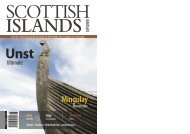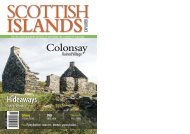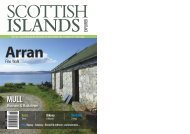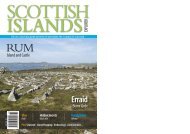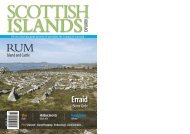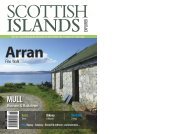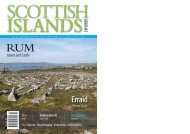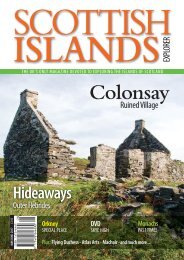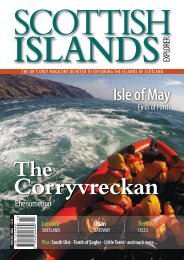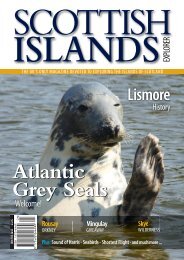Create successful ePaper yourself
Turn your PDF publications into a flip-book with our unique Google optimized e-Paper software.
A Quiet, Natural History<br />
A Quiet, Natural History<br />
‘Owing to its position, it attracts a<br />
startling variety of wildlife to a<br />
setting that is peaceful and harmonious.’<br />
A Quiet,<br />
Natural History<br />
Stephen Roberts discovers several aspects of Orkney<br />
Peace and quiet is what I associate with Orkney.<br />
I have rarely found that ambience in the<br />
modern world, somewhere I was so far removed<br />
from that I could hear wind and birdsong and little<br />
else. On the island of Hoy I drove for several miles<br />
without seeing another soul; it was the native flora<br />
and fauna that accompanied me. I have to say that<br />
I missed the human race not one jot.<br />
Orkney’s 70 islands lie only eight miles north of<br />
Caithness. Some islands, such as the two I visited,<br />
Mainland and Hoy, ring the famous Scapa Flow,<br />
the UK’s principal naval base during the two<br />
World Wars. 6,000 years’ worth of human<br />
endeavour, from stone circles and chambered<br />
tombs, to gun batteries and the latest renewable<br />
energy technology, are part of this landscape.<br />
The natural landscape is predominantly<br />
moorland, bog and heath, with an almost<br />
complete absence of woodland, one notable<br />
exception being Happy Valley, consciously<br />
created in the second half of the 20th Century to<br />
give the islands something they lacked, a clump<br />
of some 700 trees. Colour is provided by<br />
wildflowers, which take root almost anywhere.<br />
Only Found<br />
Once or twice I stopped to admire sweeping<br />
collections of poppies growing on verges. The<br />
rare Scottish primrose, with purple flowers<br />
(yellow centre), is only found on Orkney and<br />
northerly parts of mainland Scotland. The<br />
equally rare great yellow bumblebee inhabits<br />
the same kind of area.<br />
Off the north-western tip of Mainland is<br />
Birsay, a tiny island, once Orkney’s most holyplace,<br />
where patron-saint, Magnus, was<br />
buried before being exhumed and carted off<br />
to Kirkwall. Reached at low tide via a<br />
causeway, the islet’s turf is sometimes covered<br />
with pink Armeria (thrift or ‘sea pink’ due to<br />
colour and location).<br />
Sea-birds nest on cliffs, including a colony of<br />
Arctic tern and the Atlantic puffin, one of<br />
Orkney’s trademark birds. The best place to see<br />
this colourful but often elusive creature is on<br />
Westray, one of the outliers. Orkney is a fine<br />
UK’s haunt for seabirds, with 21 breeding<br />
species. There are 13 RSPB reserves where<br />
resident and migrant birds can be observed.<br />
32 SCOTTISH ISLANDS EXPLORER MAY / JUNE <strong>2017</strong><br />
MAY / JUNE <strong>2017</strong> SCOTTISH ISLANDS EXPLORER 33



